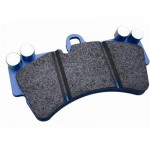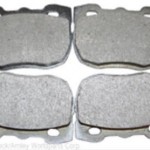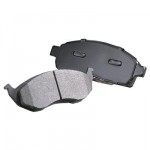For all that we ask them to do, disc brake pads don’t get a whole lot of respect. As long as they fit in the caliper and do a reasonable job of stopping the vehicle, a pad is a pad, right?
When it comes to high performance and racing, that common perception of brake pads is not only wrong, it can be downright dangerous. You can’t throw a set of typical auto parts store pads on your high-powered street machine and expect them to hold up for any length of time. On a circle track or road race car, those pads can fail without warning, costing you a race, your car, or worse.
The world of performance brake pads is filled with a bewildering array of compounds with different materials, wear ratings, friction values, and temperature ranges. Companies like EBC Brakes, Hawk Performance, Power Stop, and Wilwood make brake pads for very specific performance levels. Even OE-replacement manufacturers like Bendix offer pads tailored for everything from Grandma’s go-to-church-on Sunday sedan to high performance sports and muscle cars.
In this post, we’ll cover three things you need to consider when choosing brake pads.
1. Brake Pad Materials
A disc brake pad is a simple thing. It’s composed of a formed pad of friction material mounted on a steel backing plate. The composition of the friction material is one part science and one part black art—some pad manufacturers have more than 50 different compounds available!
Back in the good old days, manufacturers used asbestos to bind the friction compound materials together. When asbestos was phased out back in the early 1990s, pad makers went looking for a new material. The industry settled on three types—non-asbestos organic, semi-metallic, and ceramic.
Organic pads have a non-asbestos organic friction/binder material; the pads must have less than 20% metallic content to be labeled organic. The main benefits of organic pads are quiet operation and longer rotor life. However, organic pads typically do not last as long or perform as well in high temperature applications like towing or racing. EBC Brakes Greenstuff 2000, Greenstuff 6000, and Greenstuff 7000 series pads are high-quality organic street formulations that offer stopping performance on par with semi-metallic pads without the metal-to-metal contact and accompanying rotor wear.
Semi-metallic pads are made of a hard resin matrix with steel fibers added to increase hardness and prolong pad life. It’s probably the most common pad available—most cars and light trucks on the road use semi-metallic pads. One big advantage of a metallic pad is improved high temperature performance; its grip actually increases as the pad warms up to operating temperature. That makes semi-metallics ideal for heavy-duty use, such as high performance street, towing, circle track, or road racing. A downside to semi-metallic pads is noise—the pads’ hardness and steel fibers increase metal-to-metal contact with the rotors and tend to magnify noise-producing vibrations rather than dampen them.
Ceramic pads are the latest type of disc brake material. As the name implies, this friction material contains ceramic fibers as part of the binder. Ceramic is a good choice for the street because it offers stable, predictable friction characteristics, especially at lower temperatures. Ceramic pads also provide a consistent pedal feel that is unaffected by hot or cold. Ceramic pads are quieter than semi-metallic and organic pads and generate low amounts of light-colored brake dust so it isn’t as noticeable on your wheels.
So which type of pad is the right one for your application?
If you are looking for stock replacement brake pads on a street-driven vehicle, stick to the type specified by the factory. If your truck came with semi-metallic pads, for example, use semi-metallic replacement pads to maintain proper braking performance.
You can also upgrade to performance brake pads. Upgrading your pads will help decrease stopping distances and improve pedal feel—and make you safer. You can safely switch from organics to semi-metallic or ceramic pads, or go from semi-metallic to ceramic and vice-versa. Here is a general guideline to help you choose the right type of performance brake pad:
Semi-Metallic Pads
• High-horsepower street cars
• Tow vehicles and heavy-duty hauling (passengers or cargo)
• Racing, especially circle track and road racing
• Severe-duty applications that generate high brake temperatures (hilly/mountainous terrain, city or other heavy stop/go driving, etc.)
Ceramic Pads
• Daily-driven vehicles
• Performance-oriented, street-driven vehicles
• Applications where improved pedal feel, longer rotor life, and low noise/low dust are important
2. Brake Pad Temperature Ratings
Choosing a brake pad for a race car is more involved than choosing a pad for a street-driven vehicle. The pads must be able to function at the temperatures reached on the track. In other words, the brakes should not fade at operating temperatures.
According to the folks at Wilwood, pad compounds rated for temperatures of 1,000 degrees Fahrenheit and up are usually necessary for most asphalt circle and road race applications. Dirt track, drag racing, and high-horsepower street performance applications can use pads rated at temperatures between 500 and 1,000 degrees Fahrenheit.
Keep in mind, though, these are general recommendations—not absolute values. Things like track length, brake cooling (airflow to the brakes), weather, and tire selection can affect brake temperatures. Like any other upgrade, the best way to find the right brake pad is run them at the track. You might have to go through a couple sets to find the pad that provides the best overall performance.
3. Brake Pad Brands
As a rule of thumb, stick with proven brands when shopping for brake pads. This is especially important when choosing pads for racing or towing, where brake failure can lead to disaster very quickly. High-quality brands may cost more, but you will get the performance you’re paying for.
Check back soon for tips on properly bedding your new brake pads.




Teaching customers hand on experiance means alot.
Teaching customers hand on experiance means alot.
Great Info!
need pads for a off roading car ? like SAE Baja
Thank you for all this great information about brake pads! S=It’s nice to know that you need to look at the material. It would be nice to find something that will last a long time. http://www.stopmasterbrakes.com.au/
Thank you for all this great information about choosing car brakes. One thing that really stood out to me is that you say to make sure that you look at brands when looking, It would be nice to know that you are going to get a brand that is going to last.
Such a great post. I read it, I Found it’s really useful and helpful to all. Keep Posting.
[…] How to Choose Brake Pads […]